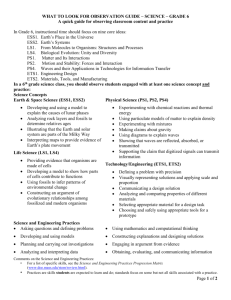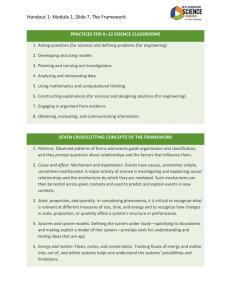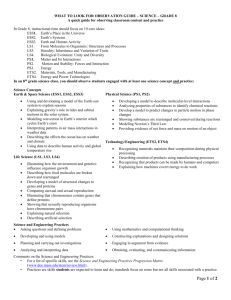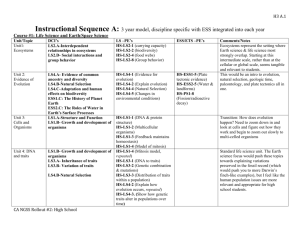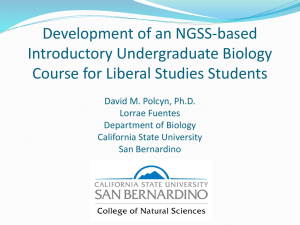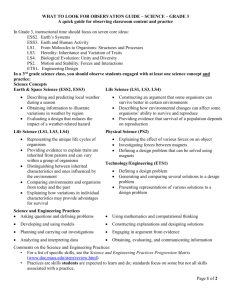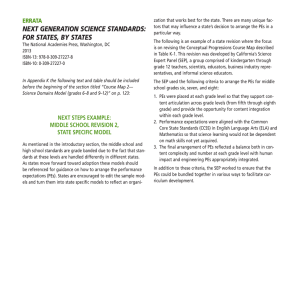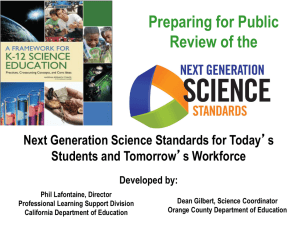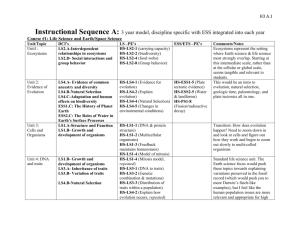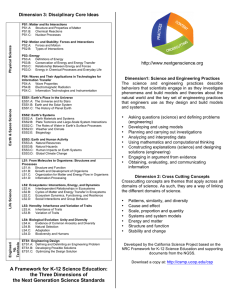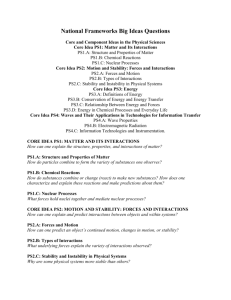NGSS Overview PowerPoint - April 2013
advertisement
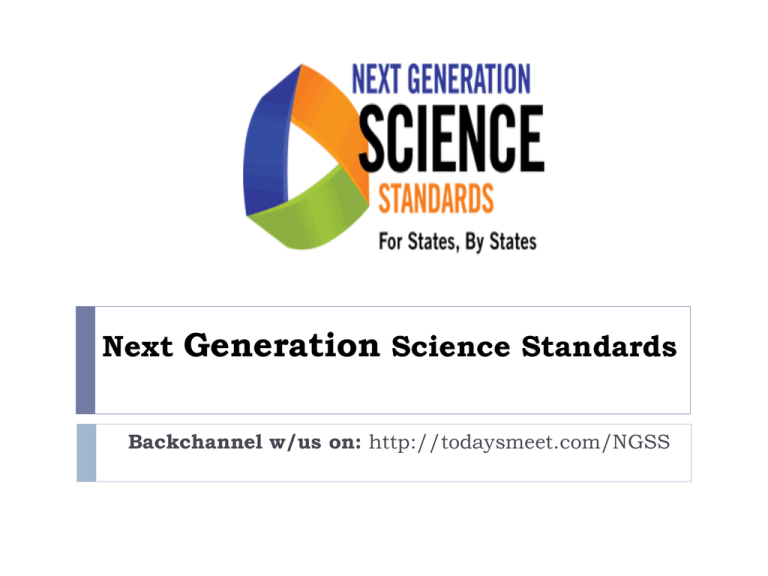
Next Generation Science Standards Backchannel w/us on: http://todaysmeet.com/NGSS Developing the Standards 2 Developing the Standards Assessments Curricula Instruction Teacher Development July 2011 2011-2013 Where is WI at in this process WI was not a lead state, but input was sought by WI and a Leadership team was developed and met regularly over the last year and a half. WI – Decision to adopt the NGSS will be up to Tony Evers once the Standards are released. We have one teacher from our State who is on the writing team. She works w/Elementary ELL students, she will be at our three day NGSS workshop in the summer. Looking into developing a ‘fast track’ earth science certification for HS requirements. Working w/CESA’s for a Statewide Roll-Out plan Survey – of Familiarity w/Framework How many of you read the Framework for K-12 Science Education? How many of you read the first draft of the NGSS? How many of you read the 2nd draft of the NGSS? 1) Read them 2) Submitted Comments individually 3) Submitted Comments as a Group Principles in the Framework: • • • • • • Children are born investigators Understanding builds over time Science and Engineering require both knowledge and practice Connecting to students’ interests and experiences is essential Focusing on core ideas and practices Promoting equity Integration of the Three Dimensions The practices are the processes of building and using the core ideas to make sense of the natural and designed world, and the cross cutting concepts hold the discipline together. Crosscutting Concepts Practices 7 8 Core Ideas 44 Architecture Closer Look at a Performance Expectation Construct and use models to explain that atoms combine to form new substances of varying complexity in terms of the number of atoms and repeating subunits. [Clarification Statement: Examples of atoms combining can include Hydrogen (H2) and Oxygen (O2) combining to form hydrogen peroxide (H2O2) or water(H2O). [Assessment Boundary: Restricted to macroscopic interactions.] Performance expectations combine practices, core ideas, and crosscutting concepts into a single statement of what is to be assessed. They are not instructional strategies or objectives for a lesson. Closer Look at a Performance Expectation Construct and use models to explain that atoms combine to form new substances of varying complexity in terms of the number of atoms and repeating subunits. [Clarification Statement: Examples of atoms combining can include Hydrogen (H2) and Oxygen (O2) combining to form hydrogen peroxide (H2O2) or water(H2O). [Assessment Boundary: Restricted to macroscopic interactions.] Performance expectations combine practices, core ideas, and crosscutting concepts into a single statement of what is to be assessed. They are not instructional strategies or objectives for a lesson. Closer Look at a Performance Expectation Construct and use models to explain that atoms combine to form new substances of varying complexity in terms of the number of atoms and repeating subunits. [Clarification Statement: Examples of atoms combining can include Hydrogen (H2) and Oxygen (O2) combining to form hydrogen peroxide (H2O2) or water(H2O). [Assessment Boundary: Restricted to macroscopic interactions.] Performance expectations combine practices, core ideas, and crosscutting concepts into a single statement of what is to be assessed. They are not instructional strategies or objectives for a lesson. Inside the NGSS Box Title and Code Performance Expectations Two sets of performance expectations at different grade levels may use the same name if they focus on the same topic. The code, however, is a unique identifier for each standard based on the grade level, content area, and topic of the standard. A statement that combines practices, core ideas, and crosscutting concepts together to describe how students can show what they have learned. Clarification Statement A statement that supplies examples or additional clarification to the performance expectation. What is Assessed A collection of several performance expectations describing what students should be able to do to master this standard Foundation Box The practices, core disciplinary ideas, and crosscutting concepts from the Framework for K-12 Science Education that were used to form the performance expectations Connection Box Other standards in the Next Generation Science Standards or in the Common Core State Standards that are related to this standard Assessment Boundary A statement that provides guidance about the scope of the performance expectation at a particular grade level. Lowercase Letters Lowercase letters at the end of practices, core ideas, and crosscutting Concepts designate which Performance expectation incorporates them. Scientific & Engineering Practices Activities that scientists and engineers engage in to either understand the world or solve a problem Disciplinary Core Ideas Concepts in science and engineering that have broad importance within and across disciplines as well as relevance in people’s lives. Crosscutting Concepts Ideas, such as Patterns and Cause and Effect, which are not specific to any one discipline but cut across them all. Changes: Draft #1 to Draft #2 - Nature of Science was included much more (expect more integration) - Technology, Engineering and Applied Science more integrated. -Math more integrated and closer look at progression. - REDUCED amount of content -Corrected some science -Appendicies were added for more support and resources -95% of the Standards were changed Recommendations for Draft #2 from both NSTA/AAPT NSTA Recommendations For Final Doc. Need to emphasize the importance of Foundation Boxes versus Performance Expectations Contain the fundamental aspects of learning goals for teaching and planning instruction Performance Expectations to be used at the conclusion of learning for assessment NSTA Recommendations All elements listed in Appendix H be included in standards for all students Reduce the size and scope of the standards: fewer concepts, less complexity at each grade level Include guidance on the time and resources necessary for implementation AAPT Recommendations Clarify and correct scientific inaccuracies in the disciplinary core ideas Do not associate only one science and engineering practice with one disciplinary core idea – prefer any practice/s with any DCI Clarify wording of performance expectations AAPT Recommendations Correct science content so that science teachers do not doubt credibility of entire enterprise Question Model Pathway 3: just a restatement of standard biology-chemistryphysics pathway Concerned about the imbalance in number of DCIs associated with biology as compared to chemistry and physics What is staying the SAME… Crosscutting Concepts Core Ideas Practices Scientific and Engineering Practices 1. Asking questions (for science) and defining problems (for engineering) 2. Developing and using models 3. Planning and carrying out investigations 4. Analyzing and interpreting data 5. Using mathematics and computational thinking 6. Constructing explanations (for science) and designing solutions (for engineering) 7. Engaging in argument from evidence 8. Obtaining, evaluating, and communicating information Disciplinary Core Ideas Life Science Physical Science LS1: PS1: Matter and Its Interactions LS2: From Molecules to Organisms: Structures and Processes Ecosystems: Interactions, Energy, and Dynamics LS3: Heredity: Inheritance and Variation of Traits LS4: Biological Evolution: Unity and Diversity PS2: Motion and Stability: Forces and Interactions PS3: Energy PS4: Waves and Their Applications in Technologies for Information Transfer Earth & Space Science Engineering & Technology ESS1: Earth’s Place in the Universe ETS1: Engineering Design ESS2: Earth’s Systems ETS2: Links Among Engineering, Technology, Science, and Society ESS3: Earth and Human Activity DCI – Disciplinary Core Ideas A core idea for K-12 science instruction is a scientific idea that: • Has broad importance across multiple science or engineering disciplines or is a key organizing concept of a single discipline • Provides a key tool for understanding or investigating more complex ideas and solving problems • Relates to the interests and life experiences of students or can be connected to societal or personal concerns that require scientific or technical knowledge • Is teachable and learnable over multiple grades at increasing levels of depth and sophistication Life Science LS1: From Molecules to Organisms: Structures and Processes LS1.A: Structure and Function LS1.B: Growth and Development of Organisms LS1.C: Organization for Matter and Energy Flow in Organisms LS1.D: Information Processing LS2: Ecosystems: Interactions, Energy, and Dynamics LS2.A: Interdependent Relationships in Ecosystems LS2.B: Cycles of Matter and Energy Transfer in Ecosystems LS2.C: Ecosystem Dynamics, Functioning, and Resilience LS2.D: Social Interactions and Group Behavior LS3: Heredity: Inheritance and Variation of Traits LS3.A: Inheritance of Traits LS3.B: Variation of Traits LS4: Biological Evolution: Unity and Diversity LS4.A: Evidence of Common Ancestry and Diversity LS4.B: Natural Selection LS4.C: Adaptation LS4.D: Biodiversity and Humans Earth & Space Science Physical Science ESS1: Earth’s Place in the Universe ESS1.A: The Universe and Its Stars ESS1.B: Earth and the Solar System ESS1.C: The History of Planet Earth PS1: Matter and Its Interactions PS1.A: Structure and Properties of Matter PS1.B: Chemical Reactions PS1.C: Nuclear Processes PS2: Motion and Stability: Forces and Interactions PS2.A: Forces and Motion PS2.B: Types of Interactions PS2.C: Stability and Instability in Physical Systems ESS2: Earth’s Systems ESS2.A: Earth Materials and Systems ESS2.B: Plate Tectonics and Large-Scale System Interactions PS3: Energy ESS2.C: The Roles of Water in PS3.A: Definitions of Energy Earth’s Surface Processes PS3.B: Conservation of Energy and ESS2.D: Weather and Climate Energy Transfer ESS2.E: Biogeology PS3.C: Relationship Between Energy ESS3: Earth and Human Activity and Forces ESS3.A: Natural Resources PS3.D:Energy in Chemical Processes ESS3.B: Natural Hazards and Everyday Life ESS3.C: Human Impacts on PS4: Waves and Their Applications in Earth Systems Technologies for Information ESS3.D: Global Climate Transfer Change PS4.A: Wave Properties PS4.B: Electromagnetic Radiation PS4.C: Information Technologies and Instrumentation Engineering & Technology ETS1: Engineering Design ETS1.A: Defining and Delimiting an Engineering Problem ETS1.B: Developing Possible Solutions ETS1.C: Optimizing the Design Solution ETS2: Links Among Engineering, Technology, Science, and Society ETS2.A: Interdependence of Science, Engineering, and Technology ETS2.B: Influence of Engineering, Technology, and Science on Society and the Natural World Note: In NGSS, the core ideas for Engineering, Technology, and the Application of Science are integrated with the Life Science, Earth & Space Science, and Physical Science core ideas Note: In NGSS, the NATURE of SCIENCE has also been ADDED more integrated. Progressions The science standards are written providing a progression to facilitate coherence in learning of these ideas over the course of schooling. Science 25 January 2013: Vol. 339 no. 6118 pp. 396-397 AAAS “Descriptions of the successively more sophisticated ways of thinking about an idea that follow one another as students learn” (Wilson & Bertenthal, 2005) Progressions “ If mastery of a core idea in a science discipline is the ultimate educational destination, then well-designed learning progressions provide a map of the routes that can be taken to reach that destination. Such progressions describe both how students’ understanding of the idea matures over time and the instructional supports and experiences that are needed in order for them to make progress.” Framework Need for CLOSE reading & Understanding: If you read the above without specialized knowledge, it implies at first glance that we need telescopes to see planets. A careful reading dispels this, since obviously the moon can be seen without a scope, but if you're an elementary school teacher without a background in science you may not be aware that several planets are quite obvious in the night sky. That we can see Saturn easily in this particular part of the world surprises most folks. Science Teacher blogspot CCC – Cross Cutting Concepts Cross Cutting Concepts 1. 2. 3. 4. 5. 6. 7. Patterns Cause and effect Scale, proportion, and quantity Systems and system models Energy and matter Structure and function Stability and change Framework 4-1 CCC – Scale, Proportion, and Quantity NSTA – Webinar 3/19/13 More examples of scale NSTA Webinar 3/19/13 Understandings: CCC Scale, Proportion, and Quantity NSTA Webinar 3/19/13 Some suggestions for teaching scale http://www.youtube.com/watch?v=0fKBhvDjuy0 Scientific and Engineering Practices 1. Asking questions (for science) and defining problems (for engineering) 2. Developing and using models 3. Planning and carrying out investigations 4. Analyzing and interpreting data 5. Using mathematics and computational thinking 6. Constructing explanations (for science) and designing solutions (for engineering) 7. Engaging in argument from evidence 8. Obtaining, evaluating, and communicating information Practices: Argument Scientists engage in argument to : Defend claims using evidence and reasoning Defend models using evidence Critique the claims of other scientists - Look for sufficient and appropriate evidence Joe Krajcik, Lead Physics Writer of Science Framework Reasons Scientists use arguments Scientist use argument to defend Interpretation of data Experimental designs Method of data analysis The appropriateness of a question “In science, the production of knowledge is dependent on a process of reasoning from evidence that requires a scientist to justify a claim about the world. In response, other scientists attempt to identify the claim’s weakness and limitations to obtain the best possible explanation.” Framework Explanations in Science “The goal of science is the construction of theories that provide explanatory accounts of the world. A theory becomes accepted when it has multiple lines of empirical evidence and greater explanatory power of phenomena than previous theories” - Explains the How or Why - Relies on Evidence *The products of science are explanation and products of engineering are solutions. Argument vs Explanation Argument is part of the process of science that defends those explanations by carefully ruling out other alternative explanations and building the case that the data collected is sufficient and appropriate to serve as evidence for the current claim. What are some examples of this… Ex. Claim, Evidence, Arugument, and Explanation Progression of a Practice Greater sophistication Grades K-2 Grades 3-5 Make a claim and use evidence. Construct and support scientific arguments drawing on evidence, data, or a model. Consider other ideas. Middle School High School Construct and present oral and written arguments supported by empirical evidence and reasoning to support or refute an explanation for a phenomenon. Construct a counter argument that is based in data and evidence that challenges another proposed argument. By Gr. 12 -Identify possible weaknesses in argument and discuss them using reasoning and evidence. -Identify flaws in their own arguments and respond to criticism of others. Appendices – College and Career Ready Appendix C – Summary: http://www.biologycorner.com/2013/02/24/ngss-collegereadiness/ Apply Text Rendering Protocol: 1. Everyone read and jot some notes. Select a Facilitator and Recorder for next Activity: 2. Then go around your group ONLY one person sharing at a time for 3 rounds. 1st round everyone shares a single significant sentence and why they selected it. 2nd round – phrase, 3rd round a word. 3. Post the summary to share in Gallery Walk.

